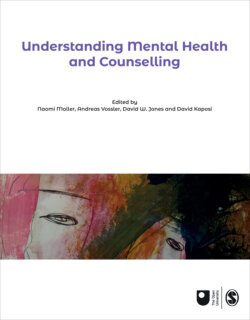Читать книгу Understanding Mental Health and Counselling - Группа авторов - Страница 34
На сайте Литреса книга снята с продажи.
Introduction
Оглавление‘Silence is enough’ by Lu Szweda
Few today would challenge the argument that therapy should be made available to people experiencing mental health difficulties. Since the mid-twentieth century, therapeutic concepts and practices have become a common motif in everyday culture, from newspaper advice columns to prime-time television. But the idea that mental distress can be ameliorated through talking with a trained professional is a remarkably modern one. As a term, ‘psychotherapy’ has existed since the 1870s, but its original usage had a wider range of meanings than it does today, including an understanding that both mental and physical ailments could be cured by hypnosis and the suggestive power of an authoritative therapist figure (Carroy, 2000; Chaney, 2017; Shamdasani, 2005; Shamdasani, 2017).
As Chapter 1 explained, the suggestion that the mind could be cured without physical treatment (or religious intervention) only emerged in earnest towards the end of the eighteenth century, with the birth of moral treatment. Freud’s invention of psychoanalysis further shifted the meaning of psychotherapy, through its unique focus on interpreting the patient’s free associations, dream content and reminiscences of childhood, as well as how the patient behaved and felt towards the analyst. In contrast with histories of psychiatry, the volume of publications specifically on the history of psychotherapy is generally smaller and has tended to focus on the development of psychoanalysis at the expense of other approaches. This chapter will examine the impact of psychoanalysis on the development of psychotherapy, but it will also look more broadly at competing ideas which emerged later in the twentieth century, and which remain influential today.
Specifically, this chapter will map the development of three of the dominant approaches to psychotherapy:
psychoanalysis and psychodynamic psychotherapies
cognitive and behavioural therapies
Rogerian counselling and the humanistic tradition.
The chapter will argue that historical research suggests we need to understand how such practices emerge within, and are shaped by, particular social and political contexts, and how psychotherapeutic knowledge has, in turn, impacted on the modern world, changing the way we understand ourselves in relation to each other.
This chapter aims to:
outline the development of the psychodynamic approach, including the influence of Freud’s Oedipus complex theory and the therapeutic concept of transference
introduce the cognitive behavioral therapies, outlining their evolution away from the ‘unconscious mind’ towards observable behavioral responses
introduce the person-centered and humanistic approaches, with their emphasis on personal growth and self-actualisation.
